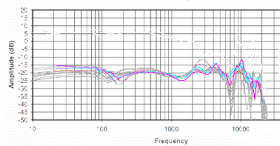Few weeks ago, I found out a gunk of glue residue was found to be melting inside the head. While Cleaning up the equipments, accuracy of the head has been modified, yet again.
Sennheiser HD650 raw response averaged
(no equalization involved here)
Gray: HMS II.3 from Innerfidelity
Green: B&K 4128C from Samsung
Cyan/Magenta: udauda's dummyhead, EURI
Beyerdynamic DT 1350 raw response averaged
(no equalization involved here)
Gray: HMS II.3 from Innerfidelity
Blue/Red: B&K 4128C from Goldenears
Cyan/Magenta: udauda's dummyhead, EURI
Sony MDR-1R raw response averaged
(no equalization involved here)
Gray: HMS II.3 from Innerfidelity
Blue/Red: B&K 4128C from Goldenears
Cyan/Magenta: udauda's dummyhead, EURI
Now EURI has been tuned to match the canal resonance frequency(canal length) of HMS II.3, but the amplitude(pinna size) is close to that of B&K and GRAS. It seems no further revision is necessary. All of previous data will be updated accordingly.




nice blog, lot's of data I can learn here
ReplyDelete언제 실제 확산음장에서 DFE만 측정해보시면 될텐데 ㅎㅎ 여하튼 대단하심다. 으으으
ReplyDelete오오 당근님! 요번에 업데이트하면서 물량을 아낌없이 투자했는데, 그만한 보람이 있는 것 같습니다. ㅠㅠ
DeleteWhat do you make of the different readings between the different setups, Rin?
ReplyDeleteAccording to QC solution providers, equipments from B&K are slightly better in terms of manufacturing-related variances. Also there is a slight emphasis of the ear canal resonance with Head-Acoustics' pinna design, which raises a question somewhat.
DeleteIn 1998, Schmitz and Bietz compared all of conventional dummy heads, and reported that "In wide frequency ranges, the curves are close to one another." IOW the conventional dummy heads available to purchase are strictly complying the relevant international standards, so you can be assured they are all "technically equal" under a set tolerance.
However, it doesn't mean the three heads from B&K, Head-acoustics, and GRAS, which are used by headphone analysis websites, are faithfully representing the HRTF of an "average human". Moller, Hammershoi, and Sorensen's data indicate the three heads actually perform the worst when it comes down to actual binaural synthesis: http://books.google.com/books?id=1pxKhlEaPXkC&q=fig.+9.10#v=onepage&q&f=false
So please take the data derived from these heads with a grain of salt, as stated on the IEC 60268-7: "... Coupler or ear simulator measurements are relatively simple, but the results bear little relation to those from subjective assessments ... They are most useful for production testing, quality control and commercial specifications ..."
Personally I find headphone measurement data useful more than anything, not because they truly represent exactly what I hear, but because they show what have been accounted when the product was designed, and consequently, reveal possible improvements in accordance to the international standard(objective quality), or to my personal taste(subjective quality).
References
A. Schmitz and H. Bietz, "Free-field / Diffuse-field Transformation of Artificial Heads", presented at the 105th Audio Eng. Soc. Convention, preprint 4801 (September 1998).
D. Hammershøi and H. Møller, “Binaural Technique – Basic Methods for Recording, Synthesis, and Reproduction,” in: Communication Acoustics, J. Blauert, ed. Springer, Berlin (2005).
IEC 60268-7 – Sound System Equipment. Part 7: Headphones, International Electrotechnical Commission, Geneva, Switzerland.
Have you thought about putting your dummy head in front of some calibrated speakers, say 30 degrees to each side? It would be interesting to see how your data would compare to Sean Olive's and Todd Welti's results, or for that matter, the diffuse-field target that you've been using.
ReplyDeleteThat would be nice, now I need a near-field speaker which has a flat response from 20 Hz to 20 kHz.
DeleteMy target is identical to the ISO 11904-2 standard, with the response above 10 kHz retrieved from Hammershoi-Moller data, as they are the author of the curve. As far as the Olive-Welti result goes, I have an idea, of which I think is brilliant. Will be released in few weeks so please stay tuned!